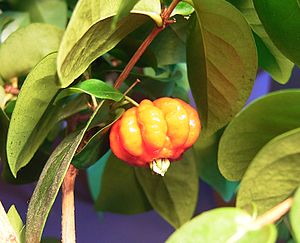Surinam cherry
| Surinam cherry | ||||||||||||
|---|---|---|---|---|---|---|---|---|---|---|---|---|

Surinam cherry ( Eugenia uniflora ) |
||||||||||||
| Systematics | ||||||||||||
|
||||||||||||
| Scientific name | ||||||||||||
| Eugenia uniflora | ||||||||||||
| L. |
The Surinam cherry ( Eugenia uniflora ), also Pitanga or cherry myrtle , is a species of the cherry myrtle genus ( Eugenia ) in the myrtle family (Myrtaceae). The specific epithet uniflora means single-flowered, because the flowers are often single in the leaf axils.
description
The Surinam cherry grows as an evergreen shrub or small tree and reaches heights of about 5 to 7 m. The brownish, relatively smooth to fine-cracked bark flakes off. The bark of the young twigs is reddish and hairy. The bark of older twigs and branches is gray-brown.
The against-constantly arranged leaves are simple and stalked. The short petiole has a length of about 1.5 mm. The glossy, dark green, slightly leathery, waxy and egg-shaped to elliptical, entire and bare leaf blade ends with a pointed to pointed and rounded tip. It is 4 to 7 cm long and 2 to 4 cm wide and has many transparent glands. There are about five secondary nerves on each side of the main nerve, each branching off from there at a 45 ° angle. The leaves of the new shoot are reddish. The leaves contain essential oils , which are released when the leaves break.
The flowers appearing in summer are solitary or up to four in the leaf axils. The four-fold, hermaphrodite and stalked flowers have a light scent. There are two small, more or less durable bracts at the bottom of the long, bare flower stalk, and at the top under the flowers two small, sloping bracts are formed. The flower cup (hypanthium) is short. The four elongated, green sepals are bent back and partly ciliate. The four petals are white and spreading to the back. The 50 to 60 free stamens have long white stamens and light yellow anthers . The square ovary is inferior with a long, conical stylus with a smaller capitate scar . There is a discus .
It takes 5 to 7 weeks from pollination to fruit. The thin-skinned, fleshy and ribbed fruits, berries ( false fruits ) are smooth, shiny and orange-red to dark purple in color, up to 2.5–4 cm in size and seven to eight times ribbed. They usually still have the green calyx tips at the top. They usually contain a relatively smooth, light brownish seed that is easily detached from the pulp, it is roughly spherical and 7 to 13 mm in size; up to three seeds can also be formed, which are then smaller and flattened at the boundary surfaces. The resinous seeds, which are relatively large for the myrtle family, cannot germinate long after they have been removed from the fruit, and drying out in particular leads to a loss of germinability. Germination is hypogean .
Occurrence
The natural range of the Surinam cherry is the eastern South America from Surinam to Uruguay . Today, however, it is planted in large parts of the tropics and subtropics. In some regions, it is however also known as invasive neophyte classified
The Surinam cherry does not make high demands on the soil if it is not too salty. It can even survive temporary moisture . It is moderately frost tolerant; Young plants down to about −2 ° C, established plants down to about −5.5 ° C. Even if it freezes back to the "root stock", it can sprout again. This enables it to colonize subtropical or high-altitude habitats with occasional frost. In Guatemala e.g. B. As a neophyte, it can penetrate at altitudes of up to 1800 m.
The Surinam cherry also survives bush fires relatively well due to its ability to sprout from the "root stock".
use
The Surinam cherry is often planted as a hedge because of its robustness and attractive foliage. The fruits can be eaten straight from the tree or processed into juices, jellies and fruit wine . Because of its short shelf life, the Surinam cherry does not play a role as an export crop. The fruits have a vitamin C content of 25 mg per 100 g.
literature
- Andreas Bärtels: Color Atlas of Tropical Plants . E. Ulmer, Stuttgart, 1989, ISBN 3-8001-3448-9 .
Web links
- Julia F. Morton: Fruits of warm climates , Florida, 1987: Surinam Cherry , pp. 386–388 at online at Purdue University, West Lafayette, USA (Eng.)
- Jie Chen & Lyn A. Craven: Myrtaceae in the Flora of China , Volume 13, p. 331: Eugenia uniflora - online .
Individual evidence
- ↑ M. da Costa Souza, Marcelo, M. Morim: Subtribes Eugeniinae O. Berg and Myrtinae O. Berg (Myrtaceae) at Marambaia Restinga, Rio de Janeiro State, Brazil. In: Acta Botanica Brasilica. 22 (3), 2008, pp. 652-683; on p. 654, 666, 671, doi: 10.1590 / S0102-33062008000300006 .
- ^ KA Wilson: A Taxonomic Study of the Genus Eugenia (Myrtaceae) in Hawaii. 1956, (PDF) at CORE, accessed September 1, 2019.
- ↑ Eugenia uniflora at Hawaiian Ecosystems at Risk project (HEAR) (Engl.)
- ↑ Global Invasive Species Database (Engl.)
- ↑ Nutritional values of the Surinam cherry on lexolino.de.


